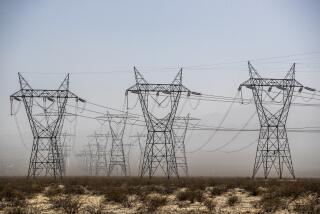Sempra Wins Deal to Supply Gas to Baja California
- Share via
SAN DIEGO — Marking another stage in Mexico’s effort to develop cleaner electricity, the government has awarded Sempra Energy a 10-year contract to supply up to $1 billion in natural gas to a new power complex in Baja California.
Sempra is the San Diego-based company formed from the merger of Enova, parent of San Diego Gas & Electric, and Pacific Enterprises, parent of Southern California Gas. The company also will build a 23-mile pipeline from the San Diego side of the U.S.-Mexico border to Rosarito, a popular weekend getaway and residential area in Baja for Southern Californians.
Mexico is under a federal mandate to wean itself from fuel oils and liquid propane as sources of power generation and commercial and residential heating because they are responsible for much of the pollution that plagues Mexico City and other urban areas.
The country also is critically short of energy in booming border areas such as northern Baja California, where U.S. and other foreign companies have flocked in recent years to take advantage of liberalized trade laws and cheap labor. Baja California also suffers from isolation--the fact that it is not connected to the rest of Mexico by the electricity power grid.
The deal, announced Thursday, affirms Sempra’s strategy of expansion in Mexico. The company is already delivering gas to residential and business customers in Mexicali and Chihuahua and hopes the deal will lead to similar franchises for Tijuana and Ensenada. Bids to distribute gas to those cities will be solicited later this year.
“It just shows that Sempra has given us a strategy and they are now following through with it,” said Donato Eassey, energy analyst with Merrill Lynch in Houston.
Under the plan, Sempra gas totaling as much as 300 million cubic feet a day will feed a new 450-megawatt power plant being built in Rosarito, as well as two existing, adjacent generating units that total 680 megawatts. They will be converted to gas use once the new plant is online in 2000.
*
The existing Rosarito units currently burn a heavy, highly polluting sulfur-laden fuel called residual oil, which is the residue left from gasoline refining. The fuel is delivered via pipeline from barges a mile offshore.
The Rosarito power complex, built in the late 1950s, supplies more than 90% of northern Baja California’s electricity.
In addition to providing cleaner electricity, the new Rosarito plant will meet the region’s booming power demand, which during peak summer load periods exceeds supply by 10%, said Stephen L. Baum, Sempra vice chairman. Currently, Baja California buys electricity from the U.S. during those periods and imports it via Sempra transmission lines.
“This caps an eight-year dream we’ve had to supply Baja California. This is our biggest international deal so far, and we are excited about it,” Baum said.
The new plant is part of an aggressive power expansion program pushed by Mexico’s Federal Electric Commission, or CFE, the near-monopoly that is the country’s largest power provider. Mexico expects to grant bids for 10 additional power plants this year, a CFE spokesman said.
Sempra apparently had no competitors on the supply bid, although El Paso Energy was interested in the project earlier, Baum said.
The complex will ultimately generate up to 1,500 megawatts of power, enough to light 3 million households by current Mexican consumption patterns. Currently, the CFE has only 650,000 metered customers in Baja California, Sempra said.
The new Rosarito power plant, a $244-million project, is being built by a joint venture of Asea Brown Boveri of Switzerland and Nissho Iwai of Japan. Construction is due to start imminently, the CFE spokesman said.
Sempra is losing money on its Mexico projects for the time being but will gain profit from them over time as they build a Mexican energy supply infrastructure, said Michael Heim, securities analyst at A.G. Edwards & Sons Inc. in St. Louis.
“It sends a nice signal that they continue to do projects in Mexico, that they are getting a piece of the action,” Heim said.
More to Read
Sign up for Essential California
The most important California stories and recommendations in your inbox every morning.
You may occasionally receive promotional content from the Los Angeles Times.













